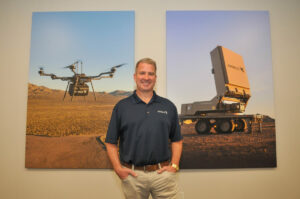To win a recent $66 million contract from the U.S. Army, Epirus Inc. had to participate in a shoot-off with two other companies — Raytheon Technologies Corp. and Leonardo DRS, both based in Arlington, Virginia.
Ken Bedingfield, chief executive of the Torrance defense contractor, said the competition, which took place in April, involved shooting down the greatest number of drones.
“The winner of the shoot-off would be selected to deliver production, support, sustainment and training,” Bedingfield said.
Epirus, which emerged victorious with its Leonidas system, will deliver to the Army four of its directed energy devices this year.
“It is the first step to get the system in the hands of the warfighter, get feedback, get information, and then for us to move forward and provide additional units for fielding of the capability to protect the U.S. warfighter as they operate around the world and deal with the threat of armed drones,” Bedingfield said.
Because the future of warfare is expected to involve battalions of unmanned drones – whether in the air or on the ground – Epirus and a few companies like it are at the forefront of today’s defense preparedness. Epirus makes systems that zero in on enemy drones and shoots them down not with bullets or missiles, but with electrical impulses.
After winning the shoot-off, Epirus underwent more system evaluation and many a meeting with the U.S. Army’s Rapid Capabilities and Critical Technologies Office to finalize the details of the contract, which was awarded in mid-January.
Epirus put in its paperwork about two weeks after the Army put out its request for proposals, Bedingfield said.
“The Army was able to move fast and put us on contract about four weeks later,” he added.
Military contracts
The Pentagon has been the main customer for the Leonidas system, and the company has contracts the Marine Corps, Navy, and Air Force, along with the Army.
“We also have a contract with the Special Operations community as well,” Bedingfield said.
While declining to discuss company revenue, Bedingfield said that as Epirus makes its deliveries to the Pentagon it will see significant revenue growth this year, growth that is projected to continue at significant levels next year and into 2025.
“That is going to create opportunities for us to build the company, continue to grow our employee base, and continue to help the U.S. military protect its warfighters,” Bedingfield said.

In a story published in February last year about Epirus receiving $200 million in a series C financing round, Reuters said that “the cash infusion comes as the United States scrambles to develop countermeasures against widely available commercial drones that military and law-enforcement officials say pose mounting tactical threats to everything from military bases and refineries to mass gatherings,” such as the recent NFL Super Bowl.
Militias and insurgent groups including the Islamic State have rigged off-the-shelf drones with explosives to attack high-profile targets including commercial ships and armored combat vehicles, the Reuters story continued.
In January of last year, Iraq’s air defenses shot down two explosive-laden drones as they approached the Ain al-Asad air base, which hosts U.S. forces and is located west of Baghdad, according to the Reuters story.
“I am very concerned about it,” Marine General Kenneth McKenzie, the then-head of U.S. Central Command, told a congressional committee in 2021, Reuters reported.
“Small, commercially available drones are one of the most persistent and dangerous threats that we see in the (Middle East),” McKenzie told the committee, according to the Reuters story.
High-powered systems
Bedingfield described Epirus’s counter-drone products as high-powered microwave systems backed by solid-state software.
“It is a system that sends out a radio frequency signal with sufficient power and sufficient energy to disrupt the electronics in the (drone’s) system and will result in it dropping out the sky and destroying the (drone),” Bedingfield said.
The signal or pulse sent out by Leonidas does not need to be customized to the drone to work effectively against it.
“The more information we have on the drone the better, but it’s not required for us to tailor it,” Bedingfield said.
As a software-defined system, Leonidas can rapidly scan through frequencies and waveforms to make sure that it is putting the right effect on the drones. It can do that thousands of times per second, Bedingfield added.
When Epirus was founded, in 2018, there were capabilities out there to take down one or two drones at a time, but nothing that could carry out a counter-swarm mission, Bedingfield continued.
As the company studied the best way to do that, it determined a high-power microwave system backed by solid-state software was the way to go.
“We determined a high-powered, solid-state system using gallium nitride chips was the best way to get the power to put it on target and effect the drones,” Bedingfield said.
Since the company has to manage the system with exact precision, it needed to invent a technology it calls SmartPower.
SmartPower allows Epirus engineers to manage the system to make sure that it doesn’t burn out the components inside of the Leonidas unit with too much energy or overheat it, Bedingfield said.
“Through AI, machine learning, algorithms and software, it senses the system, it reads it, it knows how much power it can deliver at any given time, what duty cycle it can operate at without letting the operator push it too hard,” he added.
Epirus will also incorporate SmartPower in commercial markets, including communications, security, and energy and power. The product will allow users to control the management of power digitally, as opposed to analog control.
